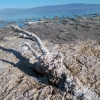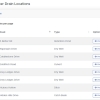
Every municipality owns drawers, or entire vaults, of ageing drainage “plan sets”: linen originals from the 1930s, blueprint mylars from the 1960s, contractor mark-ups from a 1998 sewer separation project, and everything in-between. Transforming those static sheets into a living GIS dataset unlocks powerful capabilities: automated MS4 reporting, proactive maintenance scheduling, rapid emergency response, and defensible capital-planning models.(1898andco.burnsmcd.com)
Catalogue first – Before scanning a single sheet, build a spreadsheet (or simple mobile form) that records: title, date, scale, sheet size, condition, and any known coordinate reference.
Prioritize by risk & value – Give higher priority to plans that cover high-consequence facilities (trunk mains, critical outfalls) or exist only as fragile originals.
Identify missing context – Note whether any plan links to construction diaries, field books, or inspection photos; those ancillary records often hold GPS points you will need later.
| Task | Key Points | Why It Matters |
|---|---|---|
| Surface cleaning | Dry brush, no solvents | Removes dust that reduces scan clarity |
| Flatten & repair | Low-heat humidification, archival tape | Prevents folds from distorting dimensions |
| Resolution | ≥ 300 DPI for line work; 400–600 DPI if text is faint | Meets national historic-map digitization standards(maplibrary.org, usgs.gov) |
| File format | 24-bit TIFF (lossless) + PDF derivative | TIFF retains detail; PDF is easy to view/share |
| Naming convention | e.g. DrainagePlan_ElmSt_1968_Sheet03.tif |
Keeps files sortable and script-friendly |
Large-format scanners with a straight paper path protect brittle sheets; outsourcing is cost-effective if you have < 500 sheets or no oversize scanner.
Control points – Pick at least four well-distributed, enduring features (e.g., roadway intersections, bridge abutments).
Transformation – Use a first-order affine or spline transformation in ArcGIS Pro or QGIS.
Accuracy check – RMS error ≤ 1 pixel is ideal; anything > 2 pixels may indicate an incorrect control point.
Save the world file so the scan remains geo-aware when shared.(links.esri.com, esri.com)
| Approach | When to Use | Pros | Cons |
|---|---|---|---|
| Manual digitizing | Limited budget, complex symbology | Precise, human QC inline | Time-intensive |
| Semi-automated (AI line follow) | Repetitive pipe runs on clean scans | Fast for long linear features | Requires manual clean-up |
| Outsourced conversion | Large backlog (> 2,000 sheets) | Scales quickly | Requires strict QA contract |
Key attributes to capture: pipe material, diameter, invert elevation, install date, condition notes, sheet reference, and plan scale. Tie every vector segment back to its original scan via a Source_ID field for auditability.
Adopt or adapt a recognized schema (e.g., FHWA Digital As-Builts Simplified Workflow stormwater domain) so your data plugs into asset-management systems like Roadwurx or Cartegraph without re-mapping fields later.(fhwa.dot.gov)
Recommended layers:
Structures – catch basins, manholes, inlets (point)
Conveyance – pipes, culverts, ditches (line)
Outfalls & BMPs – outfall pipes, detention ponds, rain gardens (point/polygon)
Plan sheets – georeferenced TIFF mosaics (raster catalog)
Include metadata (creation date, projection, data steward) as ISO 19115 or FGDC records—your auditors will thank you.
Attribute checks – Domain and range rules (e.g., pipe Ø cannot be negative).
Topological rules – Lines must connect to two structures; no overlapping duplicate lines.
Field spot checks – GPS a 5–10 % random sample of structures to confirm spatial accuracy; reconcile discrepancies.
Asset management – Link each feature’s Asset_ID to your CMMS so work orders sync bidirectionally.
Web viewers – Publish read-only layers for citizens or board members; sensitive data (e.g., overflow paths) can be role-restricted.
Change management – Use branch versioning or a feature‐tracking add-in so edits are auditable.
| Benefit | Impact |
|---|---|
| Faster locates | Field crews pull GIS on a tablet instead of hunting for drawers |
| Proactive maintenance | GIS highlights pipes > 50 years old for CCTV inspection |
| Regulatory compliance | MS4 annual reports auto-summarize outfall inspections |
| Resiliency planning | Flood-inundation modeling uses precise conduit data |
Case studies report up to 45 % reduction in locate times and $3 M in avoided emergency repairs within five years of digitization.(1898andco.burnsmcd.com)
| Challenge | Mitigation |
|---|---|
| Missing coordinate references | Use historic aerials or USGS 7.5′ quads as backdrops |
| Distorted scans (shrinkage, warping) | Apply rubber-sheet georeferencing; document residual error |
| Inconsistent symbology across eras | Build a lookup table that maps legacy symbols to modern asset types |
| Resource constraints | Pilot one drainage basin to demonstrate ROI before scaling |
Month 1 – Inventory & condition assessment (1,200 sheets).
Month 2–3 – Scan priority sheets; begin georeferencing.
Month 4 – Digitize structures & pipes in pilot basin; establish schema.
Month 5 – QA/QC and field validation; integrate with Roadwurx test environment.
Month 6 – Publish web viewer; present ROI metrics to leadership for full-scale funding.
Digitizing historic drainage records is not merely an archival exercise—it is a strategic move that converts dusty paper into a data asset capable of driving smarter maintenance, capital planning, and compliance. Start small, enforce rigorous standards, and build momentum; within a single construction season, your municipality can leap from paper plans to a living, GIS-driven drainage inventory that will serve you for decades.
 Wetlands are often described as the kidneys of the watershed because they filter, slow, and transform the water that passes through them in ways that …
Wetlands are often described as the kidneys of the watershed because they filter, slow, and transform the water that passes through them in ways that …
 Field inspections of catch basins, manholes, culverts, and outfalls form the foundation of responsible stormwater management. These routine checks giv…
Field inspections of catch basins, manholes, culverts, and outfalls form the foundation of responsible stormwater management. These routine checks giv…
 Habitat disruption around drainage structures is often subtle at first, and many of the earliest signs tend to appear during ordinary field work rathe…
Habitat disruption around drainage structures is often subtle at first, and many of the earliest signs tend to appear during ordinary field work rathe…
 Harmful algal blooms have become one of the most pressing water quality problems in many regions, and their rise has been linked to a complicated blen…
Harmful algal blooms have become one of the most pressing water quality problems in many regions, and their rise has been linked to a complicated blen…
 The Salton Sea is one of California’s most unusual and tragic landscapes, a place shaped by accident, transformed by ambition, and ultimately pu…
The Salton Sea is one of California’s most unusual and tragic landscapes, a place shaped by accident, transformed by ambition, and ultimately pu…
 *The screenshots used in this article are from Roadwurx, an asset management software created for road maintenance departments. Managing a town’…
*The screenshots used in this article are from Roadwurx, an asset management software created for road maintenance departments. Managing a town’…